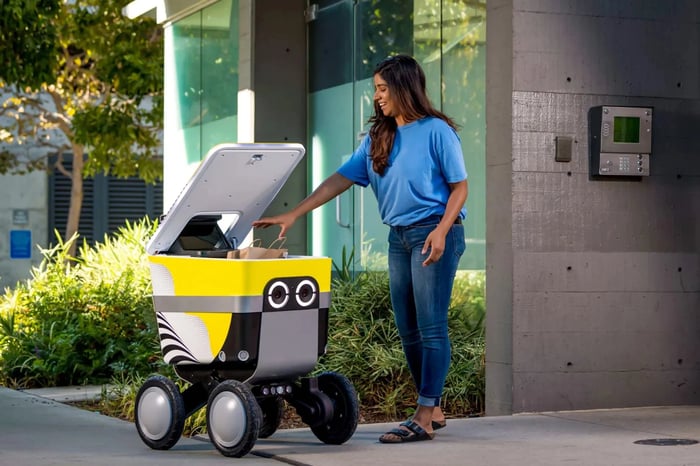Nvidia's (NASDAQ: NVDA) stock soared 2,630% over the past five years, boosting its market cap to roughly $3.5 trillion and making it the most valuable company in the world. Most of that rally was driven by its brisk sales of AI-oriented GPUs for data centers.
From fiscal 2019 to fiscal 2024 (which ended this January), Nvidia's revenue grew at a compound annual growth rate (CAGR) of 39%. But from fiscal 2024 to fiscal 2027, analysts expect its revenue to rise at an even faster CAGR of 53% as the AI market continues to expand.

Image source: Serve Robotics.
That secular trend makes Nvidia a great long-term investment, but it could struggle to replicate its millionaire-making gains from the past several years. So if you're looking for the "next Nvidia," you might want to check out the smaller AI companies the chipmaker is investing in.
One of those companies that stands out is Serve Robotics (NASDAQ: SERV), a producer of AI-powered sidewalk delivery robots. Let's see if this little $384 million company could eventually become a trillion-dollar tech giant like Nvidia.
A tiny player in a nascent market
Serve Robotics was founded in 2017 within Postmates, the food delivery service acquired by Uber Technologies (NYSE: UBER) and integrated into Uber Eats in 2020. Uber subsequently spun off Serve Robotics as an independent company in 2021, but it continued using its delivery robots to fulfill orders in select areas across Los Angeles. Its newest Gen 3 robots can travel 48 miles on a single charge, carry up to 15 gallons of cargo, and have a max speed of 11 mph. They're also resistant to extreme temperatures and heavy rain.
Serve Robotics executed a reverse merger with the blank-check company Patricia Acquisition in 2023, which paved the way to its Nasdaq listing at $4 a share on April 18. But it ended the first day at just $3.11 and sank below $3 by the end of its first month.
Today, Serve's stock trades at nearly $9. Most of that rally occurred this July after Nvidia revealed that it had taken a 10% stake in the company. That vote of confidence brought back a lot of bulls, even though the company still barely generates any revenue.
How much bigger can Serve Robotics grow?
Serve owns a fleet of 100 robots, but it only operated 59 active robots in the L.A. area for Uber Eats in the third quarter of 2024. It generated just $1.6 million in revenue in the first nine months of 2024 as it racked up a net loss of $26.1 million.
For the full year, analysts expect it to generate $1.9 million in revenue with a net loss of $34.3 million. With an enterprise value of $384 million, it might seem ridiculously overvalued at more than 200 times this year's sales. But in 2025, Serve plans to deploy up to 2,000 robots for Uber Eats across the L.A. and Dallas-Fort Worth metro areas.
Assuming it achieves that ambitious expansion, analysts expect its revenue to jump to $13.3 million in 2025 and $59.5 million in 2026. Therefore, we could argue that Serve isn't terribly expensive at about 6.5 times 2026 sales.
If Serve successfully scales up its autonomous delivery robot fleet for Uber Eats, it could attract a lot more attention from other delivery-oriented companies. Those new customers would reduce its dependence on Uber and drive its long-term growth.
According to Precedence Research, the global delivery robot market could expand at a CAGR of 32% from 2024 to 2034. That growth could be driven by labor shortages, rising e-commerce sales, and the development of more efficient autonomous robots. These little robots could also be considered a safer, cheaper, and more reliable alternative to human drivers for last-mile deliveries. So if the company can break out of its niche, it might deliver massive long-term gains.
But could Serve Robotics become the next Nvidia?
Serve might have a bright future, but it's too early to tell if it can ramp up its production, attract more customers, and diversify its business with other types of autonomous robots. So while we can't seriously call it the "next Nvidia" yet, it's easy to see why Nvidia bought a slice of this fledgling AI company. Investors who are looking for a high-risk, high-reward play in the booming AI market can consider following Nvidia's lead.
Don’t miss this second chance at a potentially lucrative opportunity
Ever feel like you missed the boat in buying the most successful stocks? Then you’ll want to hear this.
On rare occasions, our expert team of analysts issues a “Double Down” stock recommendation for companies that they think are about to pop. If you’re worried you’ve already missed your chance to invest, now is the best time to buy before it’s too late. And the numbers speak for themselves:
- Nvidia: if you invested $1,000 when we doubled down in 2009, you’d have $368,053!*
- Apple: if you invested $1,000 when we doubled down in 2008, you’d have $43,533!*
- Netflix: if you invested $1,000 when we doubled down in 2004, you’d have $484,170!*
Right now, we’re issuing “Double Down” alerts for three incredible companies, and there may not be another chance like this anytime soon.
*Stock Advisor returns as of November 18, 2024
Leo Sun has no position in any of the stocks mentioned. The Motley Fool has positions in and recommends Nvidia, Serve Robotics, and Uber Technologies. The Motley Fool recommends Nasdaq. The Motley Fool has a disclosure policy.
The views and opinions expressed herein are the views and opinions of the author and do not necessarily reflect those of Nasdaq, Inc.


